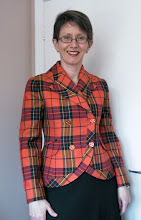If you are making anything to fit the human body, the characteristics of knitting are truly wonderful. Its geometry and the fluidity of knitting combine to allow you to make the stitches flow and grow or decrease as the case may be, turn corners, attach new garment segments sideways, make holes and close them up again as needed, and do virtually anything to make the needed shape. Knitting designers love all this stuff. But do they care about fit?
 |
| Chic Knits - Vonica Pattern |
People really like this sweater. As does The Sewing Lawyer, I hasten to add. (I actually can't wait to finish this - I SO need a black cardigan...) It's just that, from a fit perspective, it's kind of strange. More on that below, but first read about how this sweater is built.
 |
| Progress so far |
I've just finished the body, and have started on the left sleeve. To the right, you can see what it looks like so far. Once it's blocked, the fabric should actually cover me ... although this cardigan is designed to be unfastened and looks pretty good even if the front edges don't touch or overlap.
 Here's the weirdness, at least to this sewing person. Everybody knows (don't they?) that the back, above the armscye, needs to be wider and longer than the front to fit the body. If it isn't, the garment shoulders will slip to the back, as the relatively-too-short back borrows fabric from the relatively-too-long front. Moreover, the wider front shoulders will facilitate the garment's tendency to slip to the back.
Here's the weirdness, at least to this sewing person. Everybody knows (don't they?) that the back, above the armscye, needs to be wider and longer than the front to fit the body. If it isn't, the garment shoulders will slip to the back, as the relatively-too-short back borrows fabric from the relatively-too-long front. Moreover, the wider front shoulders will facilitate the garment's tendency to slip to the back. Bonnie Marie Burns did not follow these "rules". This pattern has many fewer stitches at the shoulder line in the back (22 in my size) than the front (29). In the intended gauge of 20 stitches to 4" (10cm) that's a dimensional difference of about 1.4" (3.5cm) Personally, I think the back fits my relatively narrow shoulders correctly. At left, you can see that the edge of the back armscye lies pretty much straight down from the shoulder point. At right, a view from above showing that, as I would have expected, the actual shoulder line (red) is slipping to the back. The blue line is the actual top of the shoulder. Believe me, the edge of the sleeve at front is falling off the shoulder. The fit of this cardigan is going to be quite different in the front than it is in the back. Neither is, in the abstract, wrong or bad, but shouldn't they match?
I get that knitting is different from sewing, and its qualities allow different fitting norms to apply. But do they have to be so different? Is there something technical that requires this garment to be constructed this way?Or should The Sewing Lawyer stop fussing and enjoy the process?




It's a beautiful pattern.
ReplyDeleteYou've just explained why I so seldom wear my Cerisara from the same pattern designer. http://www.chicknits.com/catalog/cerisara.html
ReplyDeleteIt, too, starts w/ a provisional cast on at the shoulders. While this may look nice, it stretches out horribly. And getting the lace pattern to match at the shoulders w/ the 1/2 stitch offset of a provisional cast-on was a nightmare.
Then the pattern calls for increases only at the sides. It would really be more flattering to spread out the increases--but that may not be an issue for the slimmer-hipped.
I agree w/ you about having more width in the back than the front. However, knits are forgiving enough that they generally have equal # of stitches F and B. I wonder if the back for this sweater has fewer stitch count for all sizes? Perhaps it is just for an even # of pattern repeats?
Personally, I think the sweater would have been better structured if I had started at the bottom and then did a 3-needle BO at the shoulders and back neck to give it a firm edge.
Have you tried Heidi Kirmaier's patterns? I have knit 2 of them and have the utmost respect for her aesthetic and architectural abilities.
http://www.ravelry.com/designers/heidi-kirrmaier
I will be making one, have several in my favorites!
DeleteSeriously, too much thinking makes your brain hurt! If it seems to be fitting nicely, I say, enjoy the ride. Mind you, badmomgoodmom might be a better one to listen to. Seems she knows a bit about the designer from experience...
ReplyDeleteI went and looked at the examples on Rav - the sweater has an armscye that is square at the bottom, rather than curving in under the arm, so perhaps that extra squareness gives some width to the back? This shows up in Reluctantmango's example. It does seem to be a drop-shoulder look.
ReplyDeletePamela
Many of my RTW sweaters have shoulder seams that fall slightly to the back as in your picture. I don't notice any problem in wearing them. Perhaps it is a design "standard" for knitting?
ReplyDeleteLovely pattern. I hope you are pleased with the final result.
Lois K
You make really good points. As a seamstress first and a knitter 2nd or maybe 3rd I find that fitting is sometimes an after thought to construction in knitting patterns, which makes sense as most knitters don't sew.
ReplyDeleteI agree with Tanya - the problem is that not many knitters sew. I do alter my knitting patterns to behave more like good sewing patterns (and we know not all of them are good..) and that is the thing to do as far as I'm concerned.. So yes, you can make some allowances for the fact that you're making stretchy fabric, but we all can see the difference between a well-cut t-shirt and another one..
ReplyDeleteMy gut is saying the same as Tanya and M-C, trust your sewing experience. The pattern is absolutely lovely, and I prefer your black to the white. I hope it turns out well for you! I'd love to see the end result.
ReplyDeleteWow - that is a lot of work. I am a sock knitter so I can see the end of the project as soon as I cast on. Kudos to you!
ReplyDeleteI have several books on how to design sweaters, and only two mention armhole and sleeve cap shaping as different for front and back. "Principles of Knitting" presents it as "bodice design for broad back" on page 499 (most recent edition of POK). "The Knitter's Guide to Sweater Design" (OOP) says on page 189, "For a garment where the front and back armholes are not shaped identically, chart each cap edge to match its respective armhole." The book is filled with charts, but it doesn't provide a chart for this. Deborah Newton in "Designing Knitwear" and Shirley Paden in "Knitwear Design Workshop" don't address the issue that I can see. Most designers (and knitters) probably feel that knits stretch, so differentiating front from back isn't necessary. Now that you've brought up the subject, I'm not sure I agree.
ReplyDeleteThanks for looking into it Mary!
DeleteI'd guess that the fronts are wider so there's ease for the cardigan to hang open without being buttoned. I generally assume that knitting is stretchy enough to forgive many sins. That and trying it on, or on a dress form, typically works for me.
ReplyDeleteI find this with knits, but in sewing too I have to make a shoulder alteration for forward shoulder. In knits I do some short rows in the right place on the back. I haven't found a way to "subtract" from the front, though. So it improves the situation somewhat but not as well as FSA in sewing. I gave up on Ravelry because I found it almost impossible to have a sensible conversation about fit. When stuck, knitters just say "Oh but knits stretch!" Yes, we know that because we also sew with knits but on Ravelry the general message about fit (especially in the so-called "Fit to Flatter" group) seems to boil down to "make it tighter" (on the basis that something as tight as a sausage skin always "fits"?). Anyway, short rows are the way to change the shape of your fabric piece in knitting. The only problem s that they don't work with all stitch patterns.
ReplyDelete